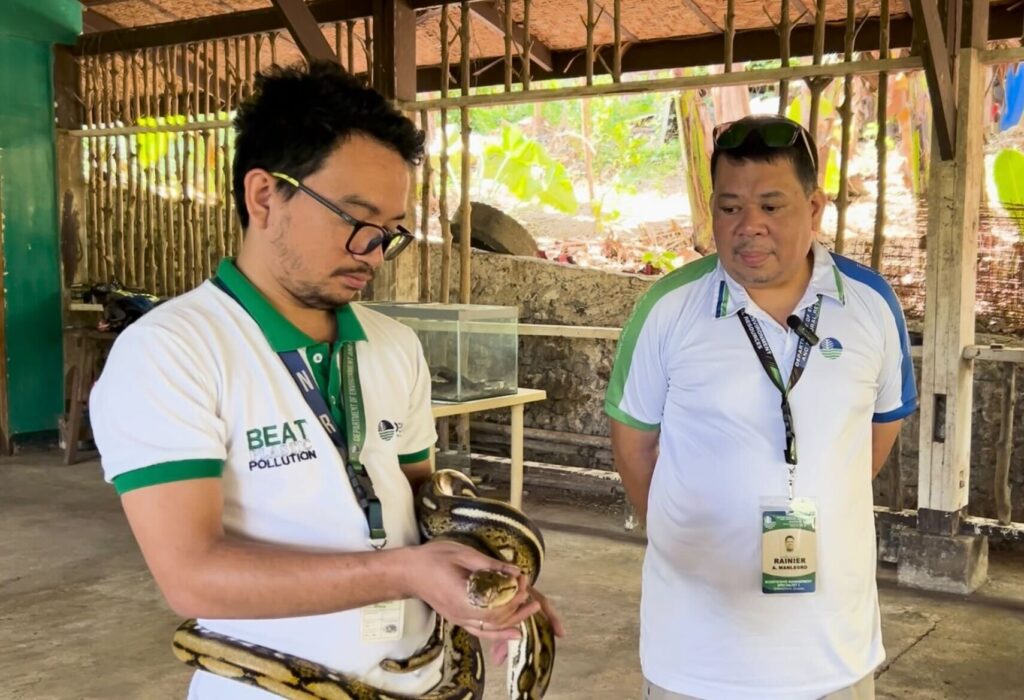
DENR-7’s ecosystem specialists Carlo Babiera (left) and Rainier Manlegro (right) shared their knowledge about snakes in a talk with CDN Digital inside the DENR Wildlife Rescue Center (WRC) in Barangay Kalunasan, Cebu City. CDN Digital photo/Christian Dave Cuizon
CEBU CITY, Philippines — They won’t attack unless provoked.
Seeing snakes in the house or anywhere could surely frighten people. Unfortunately, the shock encounter often lead to the hurting or killing of the reptile.
But what is the appropriate action to be taken when you come face-to-face with a snake?
Officers from the Department of Environment and Natural Resources in Central Visayas (DENR-7), stressed that snakes do not attack unless they feel threatened or provoked.
Carlo Babiera, Ecosystems Specialist 1 of DENR-7’s Conservation and Development Division, said that the snakes will not react if you keep a safe distance from them or not do anything that might make them feel threatened and provoked.
During a visit by CDN Digital, Babiera conducted a demonstration with a reticulated python. However, since the snake has been in captivity and was turned over to the Wildlife Rescue Center (WRC) of DENR-7 in 2019, it was no longer aggressive because it had gotten used to humans.
Carlo Babiera with the rescue center’s keeper demonstrated how the reticulated python coil its prey. CDN Digital photo/Christian Dave Cuizon
But Babiera said that if it had been in the wild and saw a human approaching, it would crawl away.
Reticulated pythons are non-venomous snakes that are distributed across Southeast Asia, according to Babiera.
READ: Why are there several sightings of king cobras in Cebu?
Moreover, based on his demo, the python had the tendency to coil or to move in a circular motion when touched. Reticulated pythons do this because they are constrictors which means they kill their prey by tightly coiling around them.
If you do not have any experience in handling snakes, the officer said that it would be impossible for a single human to handle a snake, especially the heavier and bigger ones.
Signs that a snake feels threatened
The DENR officers said that snakes have different behaviors or reactions when they feel threatened.
As for Cobras, Babiera said that they have the tendency to pause and eventually display their hoods while raising the upper part of their body. Meanwhile, for other snakes like the constrictors, he said that their neck would form an ‘S’ before they get to strike their prey.
Babiera clarified that if you do not have training or knowledge in handling a snake, it can possibly bite you, hence he suggested calling someone who is knowledgeable in proper handling of snakes for assistance.
What can provoke a snake?
In general, there are several factors that can provoke a snake, according to Rainier Manlegro, Ecosystems Specialist 2 of DENR-7’s Enforcement Division.
Among those factors is the nesting period. Manlegro said that as for King Cobras (Banakon), they are “territorial.” During this period, he said that King Cobras get highly sensitive when their body is touched.
Manlegro also clarified that most of the snakes are in flight response. “They would run away,” he said in Cebuano.
For those snakes that came from the wild, they would run away after striking at least twice.
“Why would they strike? It’s because they just defended themselves because they do not have any other defenses. Striking is their only way to defend themselves,” Manlegro said in mixed English and Cebuano.
If you chanced to enter a snake’s habitat, he advised to maintain a safe distance from the reptile.
A photo of a reticulated python in a cage inside the Wildlife Rescue Center (WRC). CDN Digital photo/Niña Mae Oliverio
What should you do when a snake enters your house?
Recent sightings of snakes in Cebu this year are not limited outside. Some of them happen right inside households.
Manlegro said that if the reptile endangers your family, killing the snake is justifiable under Republic Act 9147.
But if the snake is in its natural habitat, and your life is not endangered, there is no need to kill it.
READ: Reticulated python captured inside compound of DOH-7 in Cebu
Rainier Manlegro (right) and Carlo Babiera (left)
“Why would we kill it when we coexist in this world? We, humans, are also stewards of the creation. The important thing is we understand them (the snakes),” Manlegro said in Cebuano.
He added that understanding the behaviors of snakes is the key to avoiding them.
Who to contact first when you spot a snake?
If your life is not in danger, the agency has urged the public to report snake sightings to the authorities, emphasizing that they should first contact the nearest barangay.
Instead of killing it, Manlegro suggested it would be better not to harm the snake for you might end up getting hurt in case it fights back.
Calling the barangay is crucial especially when you do not know how to handle reptiles. The officer said that DENR has been training “wildlife enforcement officers” through the local government units (barangays) to handle wildlife.
READ: Spot a snake? Contact the barangay first for assistance
Since some sightings may be far from the DENR-7 office in Sitio Sudlon, Barangay Lahug, Cebu City, he recommended contacting the barangay first for snake rescue. After the barangay officers rescue the snake, they will turn it over to the City Environment and Natural Resources Office (CENRO), which will then pass it on to DENR-7.
If snake sightings occur in rural areas, the public should contact their local government unit (LGU) for assistance. However, if the sightings are near DENR-7’s office, they can be reached directly.
The DENR-7 hotline number for such instances is 328-3335.
ALSO READ:
Cobras in the Philippines: What you should know about them

